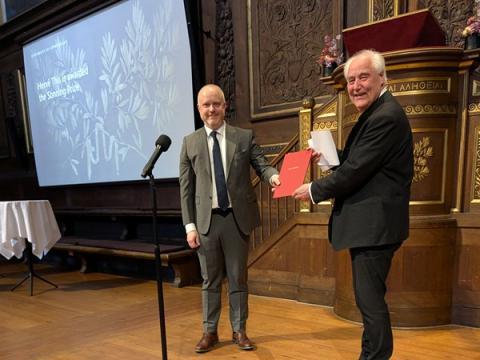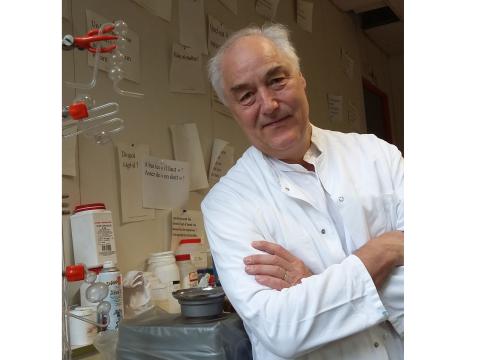
Hervé This receives the Sonning Prize 2025
April 10 2025Hervé This, a physical chemist at INRAE and consulting professor at AgroParisTech, is known as one of the fathers of the scientific discipline known as molecular and physical gastronomy, which has revolutionised European food culture. For his achievements, he has been awarded the 2025 Sonning Prize on 9 April at a ceremony at the University of Copenhagen. We meet this chemist.
Can you introduce yourself and tell us about your background?
My official name is Hervé This but I sometimes sign Hervé This vo Kientza, especially for documents in English to avoid any This/this confusion. And I am what I do: chemistry since the age of 6. That’s why I get up in a hurry in the morning, amazed that theoretical and mathematical descriptions describe the world so well. When I was a child, all my pocket money went into setting up a lab at home. At the age of 12, I knew the Palais de la découverte’s liquid nitrogen presentation so well that the organisers asked me to do it for them. Later, when I was a student at ESPCI, I made liquid nitrogen sorbets, thinking I had invented them. These sorbets later became a kind of emblem of molecular cuisine. I had two lives: my lab at home and my social life. In 1980, I began my first experimental studies of culinary phenomena, and in 1986, I met an Englishman, Nicholas Kurti, who was doing similar things in Oxford. We became friends immediately and together we created molecular and physical gastronomy. In 1995, I accepted a laboratory at the Collège de France, and I changed my life in 2000 to do my research full time at INRA.
Your career combines chemistry and cooking. What prompted you to explore these fields together?
I have always cooked. As a teenager, when I went boating in the summer, I was the one who cooked on board. At ESPCI, I cooked when we got together with friends to revise for exams. And in my student room, my laboratory ended up next to my saucepans and I started to use my chemistry equipment for cooking. But the trigger, and it was very specific, was on 16 March 1980 when I was making a Roquefort soufflé for my friends. The recipe said, ‘Put the egg yolks two at a time’. I didn’t follow the instructions and put them all together. The soufflé was a failure. The following week, I tried the soufflé again and found the strange sentence about the eggs. So I put the egg yolks in one by one, and the soufflé was a success. The next day, I decided to collect these kitchen oddities and test them in my laboratory… which I have never stopped doing since!
Can you explain the principles of molecular and physical gastronomy? How is it different from ‘molecular cuisine’? And from note-by-note cooking?
In the applications of molecular and physical gastronomy, there is indeed molecular cuisine. Molecular cuisine is the culinary technique that makes use of materials imported from laboratories. For example, if you use liquid nitrogen to make a sorbet, it is molecular cuisine. Note-by-note cuisine, or synthesis cuisine, is another application, much more recent. Instead of using classic ingredients such as meat, fish, fruit and vegetables, dishes are prepared using pure compounds: water, cellulose, pectin, polysaccharides, proteins, sugars, etc. This results in completely new consistencies and flavours: a whole world of innovation!
The Sonning Prize is a prestigious award. How does it feel to be recognised in this way for your contributions to cooking and science?

Journalists often ask me what I am most proud of, and I reply that I don’t know what pride is, because I am mainly concerned with what I am doing and what I am going to do tomorrow. Of course, I am happy about this prize because I join Niels Bohr, Karl Popper, Hannah Arendt and a few Nobel Prize winners, but I wonder how to use this prize. From a personal point of view, what amuses me is doing science, but as a citizen I force myself to apply it. I think I will use the prize to promote molecular and physical gastronomy, help me to create new molecular gastronomy research groups around the world and promote note-by-note cooking and its usefulness for the future.
Your approach to cooking is characterised by a strong interest in research and innovation. How do you think this scientific research has enriched the European culinary tradition?
I clearly see the difference between science and technology, but I also clearly see that science is the best support for innovation. It contributes to intellectual training and technical applications. It is not just a tool for improving existing techniques, it also allows for the creation of new approaches and the transformation of traditional practices. Cooking is no longer limited to an intuitive art, it is also becoming a field of experimentation where chefs can push the boundaries of culinary creation further.
With current technological advances, where do you see cooking in 10 years' time?
Molecular cuisine has been around since the 1980s and the case is now closed. The challenge is note-by-note cooking. In 2035, the population will reach 10 billion people that will need to be fed. The fight against waste is essential and, from this point of view, note-by-note cooking is an asset, offering solutions for creating food that is more efficient and sustainable, while also being more environmentally friendly. It is a way of meeting both the needs of large-scale food production and the need to preserve the planet’s resources.
As a conclusion?
To AgroParisTech’s students: enjoy these wonderful years you spend at school. Learn as much as possible from this theory that makes us grow and don’t forget that we are what we do. Have fun learning intensely, be pitbulls of knowledge: when you come across something new, sink your teeth into it and don’t let go until you have assimilated it perfectly. And don’t forget these important values: the pinnacle of intelligence is kindness and righteousness.

